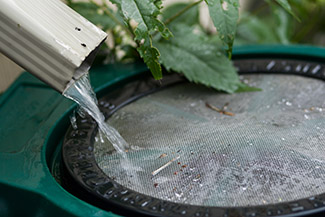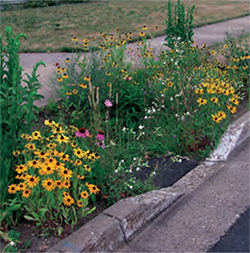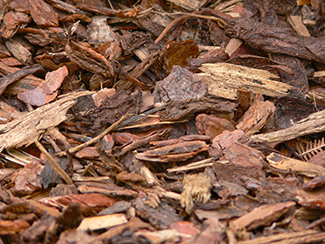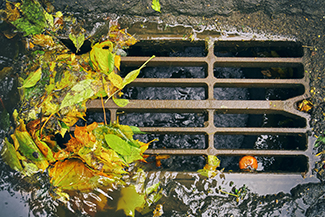Stormwater Runoff – From The Street To The Creek
![]() Have you ever wondered what happens to rain when it goes down a storm drain? It’s carried by the storm sewer and discharged into nearby waterways. This water, called stormwater runoff, is not treated…
Have you ever wondered what happens to rain when it goes down a storm drain? It’s carried by the storm sewer and discharged into nearby waterways. This water, called stormwater runoff, is not treated…
![]()
Have you ever wondered what happens to rain when it goes down a storm drain? It’s carried by the storm sewer and discharged into nearby waterways. This water, called stormwater runoff, is not treated.
It carries everything it has picked up from streets, lawns, rooftops, and other surfaces, including trash, chemicals, bacteria, and other pollutants. However, runoff isn’t just caused by rain; human activities also create it. For example, we can create runoff simply by hosing off our driveways.
In urban and suburban areas, much of the land is covered by buildings and pavement, which do not allow water to soak into the ground.
Buildings and pavement make runoff worse by increasing both the speed and the amount of water going down the storm drains. In undeveloped areas, rain fall is filtered and absorbed by soil and plants, so runoff is cleaner and less of a problem.
WHAT CAN TEXANS DO?
Keep Rain Where It’s Falling
 Harvest Rainwater
Harvest Rainwater
You can reduce runoff problems by collecting rain at home and storing it in rain barrels or a cistern to use later. Rainwater harvesting has numerous benefits.
Not only will you reduce runoff and improve water quality, you’ll also conserve a precious resource and save money on your utility bill.
Yet another benefit, rainwater is better for plants than treated water. Learn more about rainwater harvesting with our free guide.
 Install a Rain Garden
Install a Rain Garden
Another option for capturing runoff is to build a rain garden in your yard or community. Rain gardens are shallow, plant-filled basins that collect water from a roof, driveway, or street.
They hold water temporarily and allow it to soak into the ground while filtering out pollutants. These landscape features also provide food and shelter for butterflies, song birds, and other wildlife, and can make a lovely point of interest in your yard or neighborhood.
 Increase Water-friendly Surfaces
Increase Water-friendly Surfaces
You can also reduce runoff by decreasing the impervious surfaces on your property and increasing the permeable ones.
Water cannot seep into impervious surfaces, such as streets, roofs, and driveways. Permeable areas, however, allow water to soak into the ground rather than running off.
Here are a few tips to make your yard more water friendly.
- Route your downspout to an area in your yard with a permeable surface, such as pebbles or landscaping, instead of a driveway or other impervious area. This is a low cost solution, but it does require planning. Review these resources from the Environmental Protection Agencyfor more information.
- Use permeable pavements for your driveway and sidewalks, if possible. Permeable pavements infiltrate, treat, and/or store rainwater where it falls.
- Plant native vegetation and use mulch, both of which do a better job of controlling stormwater than a grass lawn. Use the Native Plant Database from the Lady Bird Johnson Wildflower Center to find species suited to your location and growing conditions.
 Control Runoff
Control Runoff
- Sweep your driveway, sidewalk, or road instead of washing it off with a hose.
- Avoid overwatering. If you start to notice runoff when watering your yard, turn off the water and wait for about an hour to allow the plants to absorb the water before your resume.
- Adjust sprinkler heads to avoid watering sidewalks, driveways, or streets.
- Wash your car in a commercial carwash. Water from washing cars contains chemicals and sediment. Car washes are required to filter this water before it is discharged into the sewer system.
 Reduce the Pollutants in Your Yard
Reduce the Pollutants in Your Yard
You can’t stop all runoff, and some is natural. However, by reducing sources of water pollutants around your home, any runoff will be cleaner.
- Don’t put anything down a storm drain—they are for rain only.
- Pick up pet waste. It does not make good fertilizer and can cause bacterial pollution.
- Dispose of used oil, antifreeze, paints, and other household chemicals properly. Find a household hazardous waste drop off facility near you and check out this guide to HHW disposal from the Texas Commission on Environmental Quality.
- Have your septic system inspected and pumped every three to five years. Malfunctioning septic systems can contaminate waterways.
- Pick up litter.
- Follow the manufacturers’ instructions when applying fertilizers, pesticides, and herbicides, and only use what you need.
- Check vehicles and yard equipment for leaks.
- Control soil erosion on your property by planting ground cover and stabilizing erosion-prone areas.
This article was originally published by Take Care of Texas, and is a department of Texas Commission on Environmental Quality.






